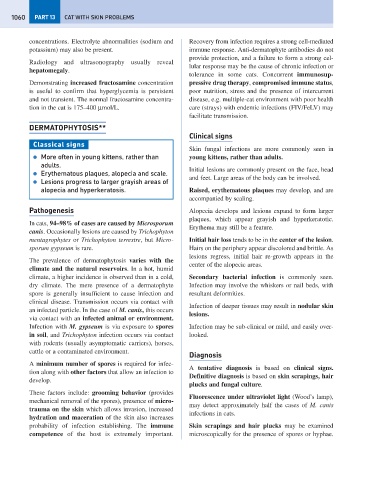Page 1068 - Problem-Based Feline Medicine
P. 1068
1060 PART 13 CAT WITH SKIN PROBLEMS
concentrations. Electrolyte abnormalities (sodium and Recovery from infection requires a strong cell-mediated
potassium) may also be present. immune response. Anti-dermatophyte antibodies do not
provide protection, and a failure to form a strong cel-
Radiology and ultrasonography usually reveal
lular response may be the cause of chronic infection or
hepatomegaly.
tolerance in some cats. Concurrent immunosup-
Demonstrating increased fructosamine concentration pressive drug therapy, compromised immune status,
is useful to confirm that hyperglycemia is persistent poor nutrition, stress and the presence of intercurrent
and not transient. The normal fructosamine concentra- disease, e.g. multiple-cat environment with poor health
tion in the cat is 175–400 μmol/L. care (strays) with endemic infections (FIV/FeLV) may
facilitate transmission.
DERMATOPHYTOSIS**
Clinical signs
Classical signs
Skin fungal infections are more commonly seen in
● More often in young kittens, rather than young kittens, rather than adults.
adults.
Initial lesions are commonly present on the face, head
● Erythematous plaques, alopecia and scale.
and feet. Large areas of the body can be involved.
● Lesions progress to larger grayish areas of
alopecia and hyperkeratosis. Raised, erythematous plaques may develop, and are
accompanied by scaling.
Pathogenesis Alopecia develops and lesions expand to form larger
plaques, which appear grayish and hyperkeratotic.
In cats, 94–98% of cases are caused by Microsporum
Erythema may still be a feature.
canis. Occasionally lesions are caused by Trichophyton
mentagrophytes or Trichophyton terrestre, but Micro- Initial hair loss tends to be in the center of the lesion.
sporum gypseum is rare. Hairs on the periphery appear discolored and brittle. As
lesions regress, initial hair re-growth appears in the
The prevalence of dermatophytosis varies with the
center of the alopecic areas.
climate and the natural reservoirs. In a hot, humid
climate, a higher incidence is observed than in a cold, Secondary bacterial infection is commonly seen.
dry climate. The mere presence of a dermatophyte Infection may involve the whiskers or nail beds, with
spore is generally insufficient to cause infection and resultant deformities.
clinical disease. Transmission occurs via contact with
Infection of deeper tissues may result in nodular skin
an infected particle. In the case of M. canis, this occurs
lesions.
via contact with an infected animal or environment.
Infection with M. gypseum is via exposure to spores Infection may be sub-clinical or mild, and easily over-
in soil, and Trichophyton infection occurs via contact looked.
with rodents (usually asymptomatic carriers), horses,
cattle or a contaminated environment.
Diagnosis
A minimum number of spores is required for infec-
A tentative diagnosis is based on clinical signs.
tion along with other factors that allow an infection to
Definitive diagnosis is based on skin scrapings, hair
develop.
plucks and fungal culture.
These factors include: grooming behavior (provides
Fluorescence under ultraviolet light (Wood’s lamp),
mechanical removal of the spores), presence of micro-
may detect approximately half the cases of M. canis
trauma on the skin which allows invasion, increased
infections in cats.
hydration and maceration of the skin also increases
probability of infection establishing. The immune Skin scrapings and hair plucks may be examined
competence of the host is extremely important. microscopically for the presence of spores or hyphae.

